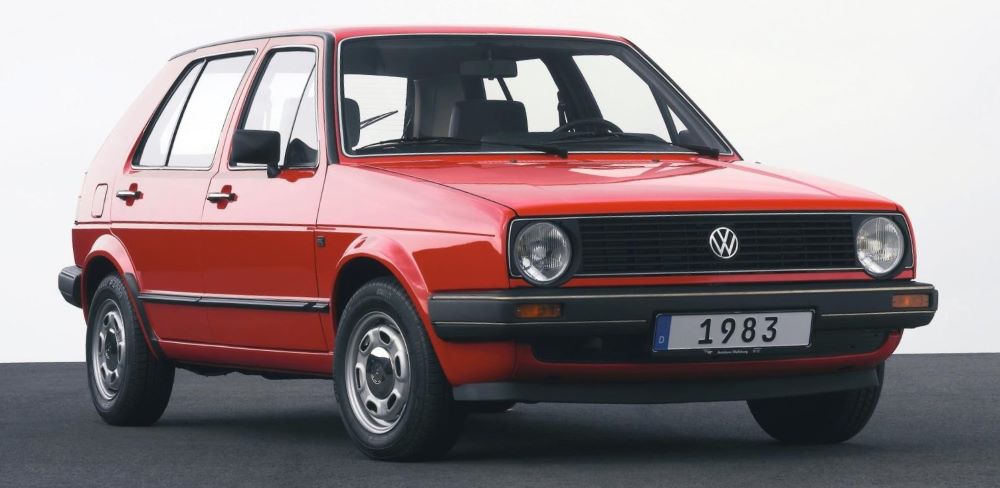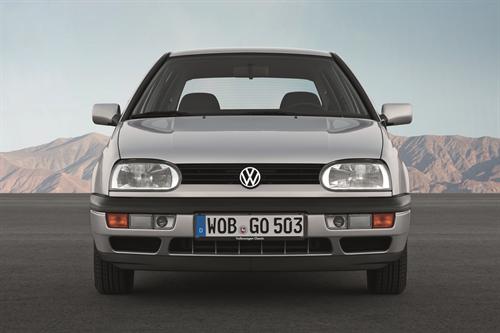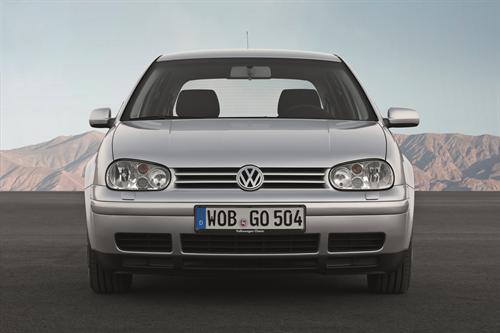BY THE GENERATIONS

Golf I: 1974-1983 (U.S.: 1975-1984 model years)
- 1.5-liter engine with 70 hp
- First sold in December 1974 as “Rabbit”
- GTI introduced in 1983 with 1.8-liter 90 hp engine
Important data on the debut of the Golf I:
- 29 March 1974: First Golf rolls off the assembly line – Start of series production
- 8 July 1974: Golf is available in showrooms of Volkswagen dealerships
- 5 August 1974: Delivery of the new Golf to customers begins
- The 1974 Golf I
- Design: 2-door and 4-door vehicles with boot lid
- Interior: Five-seater, 300-litre luggage compartment, foldable rear bench seat
- Engines: 1.1-litre four-cylinder petrol engine, 37 kW / 50 PS / 1.5-litre four-cylinder petrol engine, 51 kW / 70 PS
- Drive: Front-wheel drive, four-speed manual gearbox, three-speed automatic available as an option
- Maximum speed: 140 km/h (50 PS, manual gearbox) 160 km/h (70 PS, manual gearbox)
The first full-production Golf rolled off the line in Wolfsburg in March 1974 and was in German Volkswagen dealerships that May. The Golf wasn’t the first VW to have a transversely mounted engine driving the front wheels, however: the K70, a design taken from NSU, was first, followed by the Scirocco and the Passat. With the launch of the Golf, the new technology found its way into Europe’s highest volume vehicle class.
The Golf had a big task to fulfill: taking over from the Beetle, the world’s most successful car at the time. However, the combination of Giorgio Giugiaro’s design, the spacious interior, the car’s practicality, and its enjoyable handling won the market over to such an extent that the one-millionth Golf was produced in October 1976.

In the United States, a total of 58 Golf models—marketed under the Rabbit name—were sold in December 1974. In 1975, the first full year of Golf sales, 98,215 found buyers, with sales going over the 100,000 mark in 1976. The U.S. Golf was longer and heavier than the German versions—155.3 inches overall and more than 1900 pounds—because of its U.S.-market bumpers, but it was still built on the same assembly line in Wolfsburg, West Germany. Initially, the cars came with a 1.5-liter engine that made 70 horsepower, but a diesel model was added to the lineup for 1977. This 1.5-liter diesel four-cylinder engine produced just 48 hp, but also delivered stellar EPA estimated fuel economy ratings of nearly 50 mpg on the highway and nearly 40 mpg in the city
In July 1978, production of the Rabbit started in a new plant in Westmoreland, Pennsylvania. The Rabbit models produced in the U.S. differed from their German Golf cousins in having square instead of round headlights, larger taillights, color-matched interiors, and a softer suspension.
The Golf was an innovative force in the compact hatchback class. The original GTI invented the hot hatchback in 1976, while the later Golf GTD turbodiesel marked a breakthrough for diesels in this segment. In 1979, the Golf convertible brought a breath of fresh air into the category, debuting in the U.S. as a 1980 model, powered by a new fuel-injected 1.6-liter four-cylinder engine rated at 76 hp and mated to a standard five-speed manual transmission or an optional three-speed automatic.
While the convertible was made in Germany, virtually all other 1980 Rabbit models were now made in America—including the pickup. Over time, the Rabbit received a larger 1.7-liter engine rated at 74 hp and a 1.6-liter, 52 hp diesel. And, of course, the GTI made its debut in the US in 1983, featuring a 90-hp, 1.8-liter version of the fuel-injected four-cylinder engine.
The global sales figures added up: Volkswagen sold 6.99 million first-generation Golf models. In the U.S., about 1.5 million Golf derivatives found buyers. The Golf had proved itself a worthy successor to the Beetle.
Klaus Bischoff, Chief Designer for the Volkswagen brand since 2007, says: “The step from Beetle to Golf was truly revolutionary. Creatively, the Volkswagen designers changed from a round to an angular form, thanks to Giorgio Giugiaro’s legendary design. The main design elements of the Golf I, such as the silhouette of the upright, massive C-pillar, the prominent wheelarches, and the horizontal front with a slim grille and downwardly protruding headlights are in every Golf to the present day.”

Golf II – 1983 to 1991 (U.S.: 1985-1992 MY)
- Sold as “Golf”
- Dimensions grow by nearly 7 inches in length, 3 inches in wheelbase, and 2 inches in width
- Standard engine is revised 1.8-liter with 85 hp, GTI introduces 2.0-liter engine with 131 hp
- Catalytic converter, anti-lock braking system and power steering debut
The baby-boomer generation learned to drive on this car in Europe. It was a bit bigger than the previous Golf, having grown by 6.7 inches in length, 3.0 inches in the wheelbase, and 2.2 inches in width. According to the media release: “The level of comfort, measured by the space between accelerator pedal and rear seatback, has increased by 1.5 inches to 72.3 inches, while elbow room in the front is now 3.6 inches wider and in the back is up by 4.4 inches.”
“The most important decision in Golf history in the late 1970s was taken by the board members,” explains Marc Lichte, Senior Head of Volkswagen Exterior Design. They decided “to take the Golf I styling further, and to design the Golf II on the basis of its visual DNA. That’s where it all began, and that’s how Volkswagen created a basis for the continuous development of the series.”

The second-generation Golf introduced the catalytic converter (1984), anti-lock braking system (1986), and power steering to the compact class. An all-wheel-drive system appeared in the Syncro in 1986. As far back as 1989—some 26 years ago—Volkswagen unveiled prototype Golf models with an electric drivetrain and a hybrid drive system.
In the U.S., the market developed differently, with the emphasis on sedans rather than hatchbacks. So, from the 1980 model year, Volkswagen sent the Jetta to the U.S. market and, in the years since, it has been the most popular German car sold in the North American market. Even so, the Golf has been an important component in Volkswagen’s lineup and has been generally marketed under that name since the second-generation car went on sale in the 1985 model year.
The standard engine in the U.S. Golf II was a revised version of the GTI’s fuel-injected, eight-valve1.8-liter four cylinder, rated at 85 hp. The GTI engine had a slightly higher compression ratio and made 102 hp, while there were two versions of the 1.6-liter diesel: naturally aspirated (52 hp) and turbocharged (68 hp).
The convertible continued on the Golf I platform , but was renamed Golf Cabriolet. For the 1987 model year, the GTI received a power boost to 123 hp with the introduction of a new dual-overhead-cam, 16-valve version of the 1.8-liter four-cylinder engine; however, the diesel side lost power because the turbocharged version was discontinued. The previous GTI, using the 102-hp, single-overhead-cam, eight-valve engine, was rebadged as a “GT”.
The Westmoreland, Pennsylvania, assembly plant was shut down after the 1988 model year and the diesel Golf was dropped from the U.S. lineup. For 1989, production was split between Germany and the Puebla plant in Mexico, but the only major change during the Golf II’s remaining time in the U.S. was the introduction of a 2.0-liter engine in the GTI that produced 131 hp.
In June 1988, 14 years after its debut, the Golf had surpassed the magical production milestone of 10 million vehicles. And by the summer of 1991, a total of 6.3 million second-generation Golf models had been produced, of which around 400,000 had been sold in the US.

Golf III – 1991 to 1997 (U.S.: 1993-1999 MY)
- Design shifts to wedge shape
- Base powertrain is 2.0-liter with 115 hp, GTI moves to 2.8-liter VR6 with 172 hp
- Front and side airbags debut, advances in body construction result in improved crash safety
- VR6® engine, Ecomatic transmission, and cruise control offered for the first time
The roots of the third Golf go back to 1985 when the “A3” project—third-generation Golf, A-class—was initiated in Wolfsburg. In February 1987, Chief Designer Herbert Schäfer submitted nine different models of the next Golf to the Board, with the best design being chosen in December of that year. Schäfer said at the time: “In the first step from Golf I to II we made the car bigger, installed more powerful engines, and improved its handling. Now, in the third generation, the design takes precedence. We have found a look that is typical of the Golf: it radiates quality and safety.”
When the new generation was launched in 1991, its distinguishing features were a slight wedge shape, making it stand out from its predecessor, and a continuous chamfer underneath the window sill.

This third-generation Golf brought a new level of passive safety to the compact class when it was launched in August 1991. The Golf III was the first of the series to have front airbags, starting in 1992, while major advances in the car’s body construction resulted in improved crash safety.
There were numerous other Golf milestones with the car: the first six-cylinder VR6® engine , the Ecomatic transmission, cruise control, the first oxidation catalytic converter for diesel engines (1991), the first direct-injection diesel engines (TDI® in 1993 and SDI in 1995), and the first side airbags (1996). Also, ABS became a standard feature on all Golf models in Europe in September of 1996.
In 1993, Volkswagen also introduced a new convertible, a new all-wheel-drive model (Syncro II), and the first Golf Variant station wagon. A year later, in May 1994, Volkswagen celebrated production of the 15-millionth Golf. Including all derivatives, a total of 4.83 million third-generation Golf models were produced, with 153,613 finding buyers in the U.S.
In the U.S., the 1993 Golf base engine was a 2.0-liter, eight-valve four cylinder rated at 115 hp. The Cabriolet continued unchanged, still based on the old Rabbit chassis, but was replaced by a new car based on the third-generation Golf bodyshell for 1995. That same year, the latest iteration of the GTI went on sale, fitted with the unique 2.8-liter VR6 engine, making 172 hp and 177 pound-feet of torque.

Golf IV — 1997 to 2003 (U.S.: 1999-2005 MY)
The Golf IV was pioneering in terms of its looks and its engineering—and it transcended traditional perceptions of quality in this class. The car also continued to improve safety, with the debut of Electronic Stability Control (ESC) in 1998. The first all-wheel-drive Golf with a Haldex® clutch—the Golf 4MOTION®—also debuted in 1998. ESC became standard in Germany the following year, when the first Golf with a six-speed transmission debuted.
This Golf was created under the direction of Hartmut Warkuss, then Head of Design at Volkswagen Group, and is generally accepted as a classic. Nothing was copied from the Golf III; the windshield was flatter, the rear window steeper, and the roof extended even farther back. Giorgio Giugiaro, creator of the first Golf, expressed his admiration for the new car: “The original DNA of the Golf remains evident in its fourth generation.”
The innovations kept coming. In 2001, the 180-hp GTI was launched to mark the GTI’s 25th anniversary, while Side Curtain Protection® airbags and FSI® gasoline direct injection bowed in 2002. The same year, Volkswagen launched the R32; with a top track speed of 155 mph, it was the sportiest Golf ever and the first one to be fitted with a DSG® dual-clutch automatic transmission in 2003. The Golf IV was also the first to be fully galvanized, to feature a navigation system, and to offer Xenon headlights. Including all derivatives, a total of 4.99 million fourth-generation units were produced, of which around 180,000 were sold in the U.S.
The fourth-generation Golf didn’t go on sale in the U.S. until the 1999 model year. The base Golf’s power remained at 115 hp, while a 1.9-liter 90-hp turbodiesel joined the lineup. The VR6 returned in the GTI GLX and was now rated at 174 hp and only available with the five-speed manual transmission. The GTI GLS model was fitted with the regular 2.0-liter engine. The Cabriolet retained the 115 hp engine and lasted until the end of the ’02 model year, when it was effectively replaced by the New Beetle Convertible.
In the middle of the 2000 model year, the GTI GLS was fitted with the turbocharged, 20-valve, 1.8-liter,150-hp four-cylinder engine as standard equipment. For 2002, the 1.8T engine’s power was boosted to 180 hp and a six-speed manual transmission was added with the “337” special edition. In 2003 the VR6 engine was revised to produce 204 hp and a six-speed manual transmission was also added. More excitingly, the all-wheel-drive R32 came to the U.S. for 2004, boasting 240 hp from its 3.2-liter VR6 engine. A limited-edition model, the R32 laid the groundwork for later Golf R32 and R variants.
A TIMELINE OF INNOVATION
Golf I debut, 1974
- Transverse engine location
- Front-wheel drive
1976
- First Golf GTI
- First Golf D (diesel)
- 1 million Golf models produced
1978
- 2 million Golf models produced
1979
- First Golf convertible
- 3 million Golf models produced
1980
- 4 million Golf models produced
1982
- First Golf GTD (turbodiesel)
- 5 million Golf models produced
1983
- 6.99 million Golf I model models produced
Golf II – debut
- Power steering
- Three-point safety belt
- Limited warranty against corrosion perforation
1984
- Second Golf GTI
- Catalytic converter offered
1985
- U.S. Golf II debut
- 7 million Golf models produced
1986
- First Golf Syncro (all-wheel drive)
- First Golf GTI with 16V engine
- Anti-lock braking system for Golf Syncro
1987
- Anti-lock braking system for all Golf GT and GTI vehicles
1988
- Rallye Golf G60
- Golf Limited G60
- 10 million Golf models produced
1989
- First Golf City plug-in (electric)
- First Golf hybrid concept car
- 11 million Golf models produced
1990
- First Golf Country
- First Golf GTI with G60 engine
- Catalytic converter standard for all models
- 1 million Golf GTI models produced
- 12 million Golf models produced
1991
- 6.3 million Golf II models produced
Golf III – debut
- First Golf with VR6® six-cylinder gasoline engine
- First Golf Diesel with oxidation catalytic converter
- Immobilizer system
- Cruise control system
1992
- Driver and front passenger airbags
- 13 million Golf models produced
1993
- U.S Golf III debut
- First Golf TDI (turbocharged and direct-injection diesel engine)
- First Golf station wagon
- Second Golf convertible
- Second Golf Syncro
1994
- 15 million Golf models produced
1995
- First Golf SDI (naturally aspirated diesel/direct injection engine)
1996
- ABS standard for all Golf models
- Side airbags
- 17 million Golf models produced
1997
- 4.83 million Golf III models produced
Golf IV – debut
- First Golf V5 (five-cylinder engine)
- Fully galvanized body
1998
- First Golf 4MOTION (with Haldex clutch)
- Third Golf convertible in Europe
- Fourth Golf GTI
- Electronic Stability Control (ESC)
1999
- First Golf 4MOTION with six-speed gearbox
- Second Golf station wagon
- Brake assist
- U.S. Golf IV debut
- 19 million Golf models produced
2000
- 20 million Golf models produced
The most successful European car of all time turns 40 this year. More than 30 million Golf models have been sold since the car went on sale in May 1974 in Europe and in December of that year in the U.S (as the Rabbit). Seven generations later, the successful formula remains the same: crisp, elegant styling; space-efficient packaging; frugal yet powerful engines; and entertaining front-wheel-drive handling.
When debuted, the Golf marked a revolution for Volkswagen. The car’s water-cooled inline engines were placed transversely, driving the front wheels, whereas the Beetle’s air-cooled, horizontally-opposed engine lived at the back, driving the rear wheels.
The car was very successful in the U.S., selling more than 100,000 units in its first full year from February of 1975, the best of any new import. From 1978, Volkswagen built the Rabbit in its Westmoreland plant in Pennsylvania, selling 215,000 vehicles in 1979, an increase of 44 percent over the previous year, in a market that shrank overall by six percent.
Before Golf production was relocated to the in 1988, the Jetta sedan had assumed the role of sales leader in the U.S. market. The Golf, however, remained technically and visually related to the Jetta and has thus always been a part of the sedan’s success in this market. And the GTI—which invented the term “hot hatch” when it was launched in Europe in 1976—has remained one of the most popular compact sporty cars on the market. In fact, the U.S. is the largest single market for the iconic hot hatch.

You must be logged in to post a comment.